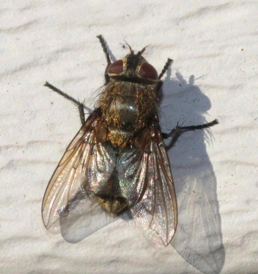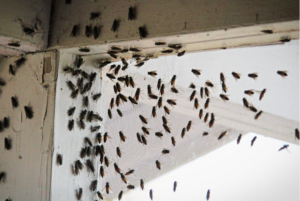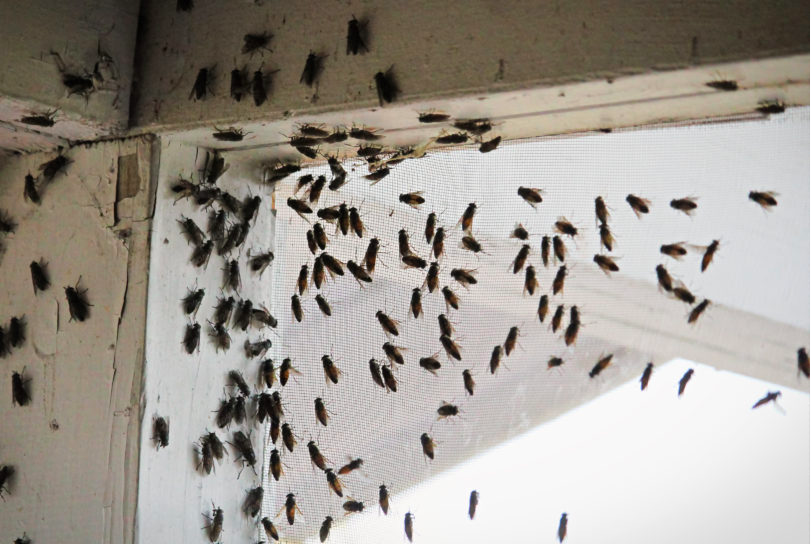Although you can come across cluster flies in your home any time of year, it is during the late fall and the early days of winter that these flies will be the most active. As the temperature drops outside these pests will seek out the warmer confines of your home to wait out the colder weather. So as the leaves start to change colours outside, keep an eye out inside for signs of a cluster fly infestation in your home.
About Cluster Flies
 Cluster flies are larger than your typical house fly. Averaging between 8-10 mm in length they are easily identified by their erratic and slow-flying patterns. It often appears as if they have no sense of direction, making them easy to swat.
Cluster flies are larger than your typical house fly. Averaging between 8-10 mm in length they are easily identified by their erratic and slow-flying patterns. It often appears as if they have no sense of direction, making them easy to swat.
Cluster flies have a dark grey belly and can be told apart by their yellow hairs, giving them a rather distinctive look. When resting, they fold their wings across their abdomen covering up the dark grey.
Females will lay their eggs in the springtime, seeking out an isolated patch of soil for each egg. The mother will lay the eggs close to earthworms as once they hatch, the larvae will burrow into the earthworm and feed off of it for approximately 3 weeks. Once it is strong enough it will then burrow into the surrounding soil for an additional 2 weeks until it is finally a young cluster fly. The whole process takes between 3 and 8 weeks depending on certain environmental factors.
Do you need wildlife removal services? Request a quote today!
Do Cluster Flies Bite?
Thy do not bite humans or other animals. Their mouths act more like a trunk and are used for sucking up nutrients as opposed to biting and chewing. Cluster flies do not carry or transmit diseases and pose no health risk to humans or house pets. Another common misconception is that the presence of these flies is a sign of poor housekeeping and unsanitary conditions, this is not the case. Cluster flies are also found in the cleanest of homes.
The biggest downside to having a cluster fly infestation in your home (outside of the nuisance factor) is the fact that eventually their presence will begin to show inside your home. Visible stains and foul smells will appear as well as the potential for food contamination. Flies will touch down on dirty surfaces regularly and then land on food or other clean surfaces. Also, if you have any family members with asthma or other breathing ailments, the build-up of excrement over time can become a negatively contributing factor for some of these conditions.
Why and How do Infestation Happen?
 As the colder weather sets in cluster flies will seek out safe places to spend the winter months. While some will find shelter outdoors, many will find their way into homes. While house flies and other pests will enter homes in search of food or a place to mate; cluster flies will enter in search of a place to hibernate for the winter. The most common places they gather in your home are in isolated areas such as your attic, wall cavities, false ceilings etc. In more extreme situations you will find them in closets, under rugs and furniture, behind curtains or any other dark, quiet space.
As the colder weather sets in cluster flies will seek out safe places to spend the winter months. While some will find shelter outdoors, many will find their way into homes. While house flies and other pests will enter homes in search of food or a place to mate; cluster flies will enter in search of a place to hibernate for the winter. The most common places they gather in your home are in isolated areas such as your attic, wall cavities, false ceilings etc. In more extreme situations you will find them in closets, under rugs and furniture, behind curtains or any other dark, quiet space.
The flies will sit on the exterior wall of your home during the warmer daylight hours and as the temperature drops, they find their way into your home through crevices and cracks. As fall turns to winter, eventually, they do not come back out during the day time and instead settle on for a long winters sleep.
Cluster flies will stay in hibernation until temperatures stead at around 12 degrees Celsius. In regions that experience warm spells throughout the winter, it is not uncommon for the flies to mistake the temporary spike in temperature for spring and all of a sudden appear in large groups in your home. If this is the case contact a licensed pest control technician to deal with the issue.
Your best bet is to keep a keen eye out in the fall for signs of these insects around your home. Catching the problem early will make resolving the problem much easier.
Vulnerable Areas of your Home
There are several vulnerable areas on any home that will allow cluster flies to gain entry. You should take a thorough look at each of the following areas for signs of the presence of flies:
- Along your roofline
- Around any wall/roof vents
- Around window and door frames
- Near any electrical access points
- In and underneath your eaves or siding
- Cracks and crevices in bricks and concrete
Even though cluster flies do not pose an immediate health threat to your family members, they can become quite the nuisance pest. They travel in swarms of up to a thousand flies and over time their excrement can cause visible stains as well as a foul odour. It’s best to contact a pest control expert as soon as you notice any signs of flies in your home. The longer you put off the problem, the more costly it will be to fix it.
How To Get Rid of Cluster Flies Permanently
The best defence is often a great offence. When dealing with cluster flies there are certain steps you can take in the fall to make your home less attractive to pests in general, and especially flies:
- Keep the areas around the perimeter of your building clean and avoid letting any water accumulate. Especialy avoid animal excrement as this will attract flies.
- Use curtains and shade whenever possible as they are attracted to sunlight.
- Keep windows shut or use screens
- Seal any obvious exterior cracks around doors, windows, utility pipes etc.
These measures will help deter flies from taking up residence on your property, but will not deal with an existing issue. If you do notice cluster flies in or around your home, you’re best to contact a pest control expert immediately. While DIY sprays will work on direct contact, it will never successfully address the entire population. A licensed pest control technician will use residual spray treatments and resolve the problem efficiently and safely.
All Wildlife and Pest Control’s government-licensed technicians are your local leaders in pest control. In business locally for over 12 years, we are experts at dealing with cluster flies as well as any other pest imaginable.

